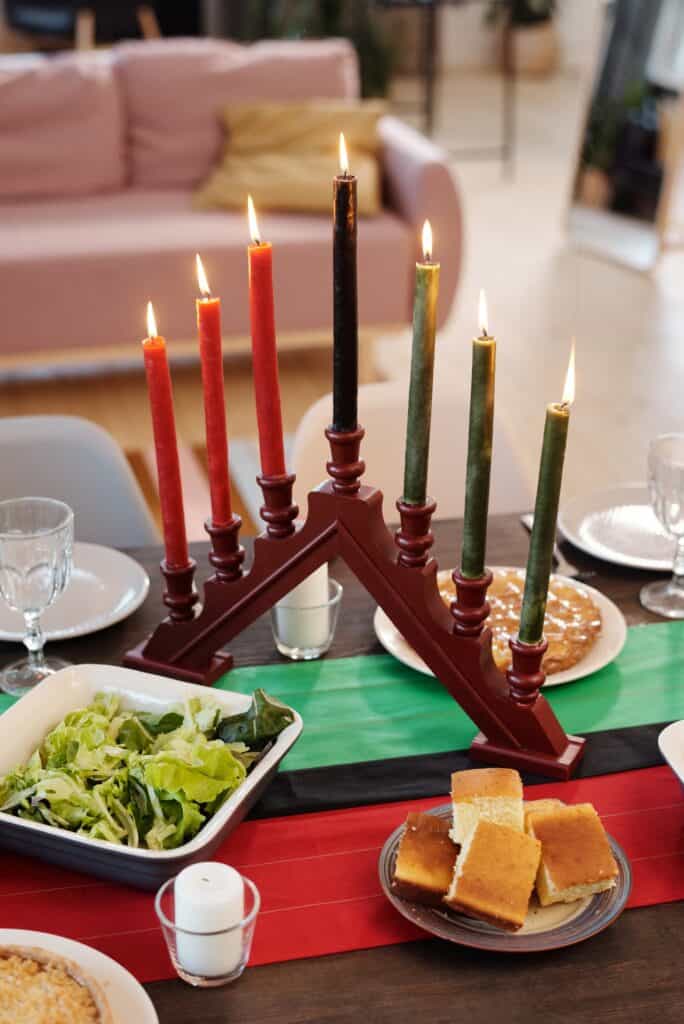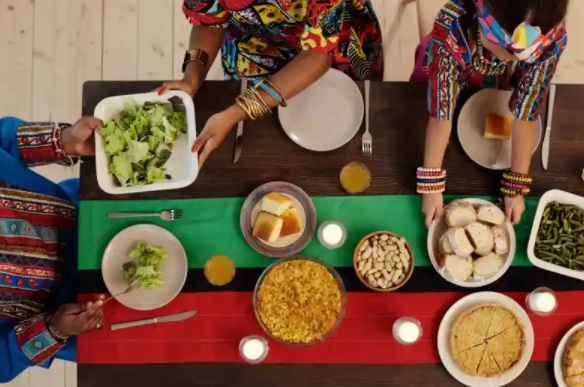
How was Kwanzaa Establish?
A professor and chairman of Black studies at California State University named Dr. Maulana Karenga, on 1966. To bring the Melanin community together persevering and reconnecting them to their roots and heritage. Thus, the holiday was born, even though its relatively new history, million of Melanin Individuals observe Kwanzaa.
Kwanzaa was designed after the first harvest celebrations in Africa, and the meaning of the name comes from the Swahili phrase “matunda ya kwanza” which means the “first fruits” of the harvest. The symbolism of the popularity of Pan-Africanism influence Karenga’s decision as a result use a Swahili term to name the celebration.
What is Kwanzaa?
An annual celebration of life that is observed for seven days from December 26 to January 1 by Melanin people This week-long cultural celebration highlights family, friends, and communities. This celebration includes singing songs, dancing, making music with drums, storytelling, and a large feast on December 31, called a Karamu.
A Kinara (candleholder) holds 7 candles each one representing the seven principles on which Kwanzaa is founded, called the Nguzo Saba, One candle is lit every night for seven consecutive nights. Emphasizing a new principle every day. There are also seven symbols associated with Kwanzaa. Value is reflected in the principles and symbols. By participating in the principles recognized during Kwanzaa we are hono=ring our heritage as people of African descent who lost a great deal of their heritage through enslavement.

The Seven Principles of Kwanzaa: Nguzu Saba
Kwanzaa celebrations are popular in the United States, Canada, and the Caribbean. Acknowledgment and honoring of its seven principles, known as Nguzu Saba. In that case in the evening candle-lighting ceremony provides an opportunity to discuss the principle and its meaning. Three red ones on the left, a black candle in the center with three green ones on the right. First, the black, candle in the center is lit and then from there you will alternate between the red and green candles starting with the red candle closest to black candle moving outwards.
1. Umoja (Unity)
Today is about maintaining unity as a family, community, and race of people. You will lite the Black candle. The family gathers together to share how they feel about one another. Therefore, simply talking can clear up many problems.
2. Kujichagulia (Self-Determination)
Today is about defining, naming, creating, and speaking for ourselves. You will lite the first red candle. This day is about togetherness and sharing traditions. Teaching a family member how to make a dish, or play the African drums. At this time you want to teach them something new or something you know how to do.
3. Ujima (Collective Work and Responsibility)
You will focus on building and maintaining your community by solving problems together. You will lite the first green candle. For the most part, the family will find a project that they can work on together.
4. Ujamaa (Cooperative Economics)
Today is about building and maintaining retail stores and other businesses. You will lite the second red candle. The family will either purchase or create a gift that the whole family can enjoy. Focus on a gift were in years to come when people see this item, they will remember this Kwanzaa.
5. Nia (Purpose)
work collectively to build communities that will restore the greatness of African people. You will lite the second green candle. In addition, the family will share dreams and Goals. This day is a great day to ask yourself or others about “What you will accomplishments in the upcoming year?”
6. Kuumba (Creativity)
find new, innovative ways to leave communities in a better way than we found it, This will not only beautify the community but create a beneficial exist. You will lite the third red candle. Let your creativity soar. Each family member will create something such as dance, painting, story, or poem. Following the family will gather and will share what they have created. In addition, you can fill the unity cup with water, wine, or juice, and have every family member take a sip in remembrance of their ancestors and to symbolize togetherness.
7. Imani (Faith)
To believe in our people, parents, teachers, and leaders. Honoring the best in our traditions and ourselves. As a result, leading to the victory of our struggle. . You will lite the third green candle. Finally, it’s time for the feast. For this reason, the family will gather and enjoy delicious food choices you desire and have a wonderful feast.
Symbols of Kwanzaa
The Symbols of Kwanzaa include:
Mazao (Crops): these crops symbolize African harvesting celebrations as well as the rewards of productivity and collective labor.
Mkeka (Mat): the mat symbolizes the foundation of the African tradition and heritage.
Kinara (Candleholder): the candleholder symbolizes African roots.
Muhindi (Corn): corn represents children and the future, which belongs to them.
Mishumaa Saba (Seven Candles): emblematic of Nguzo Saba, the seven principles of Kwanzaa. These candles embody the values of the African ancestors.
Kikombe cha Umoja (Unity Cup): symbolizes the foundation, principle, and practice of unity signifying community.
Zawadi (Gifts): represent parental labor and love. Also symbolizes the commitments that parents make to their children.
Bendera (Flag): the colors of the Kwanzaa flag are black, red, and green. Marcus Mosiah Garvey establishes these colors as freedom and unity. For instance, the black is for people; red, the struggles endured; and lastly green, for the future and hope of their struggles.
Fruit: The fruits are symbolism of both joy and the results of collective hard work.

6 Tips to make this Kwanzaa a memorable one
If you’ve never celebrated the holiday before (or you have but want to learn even more). Therefore, here are a few things to make a great impression this holiday.
1.Get crafty:
Alongside the symbols and principles, you have gift-giving every day during Kwanzaa. Why not try DIY gifts. Personal handmade gifts are very traditional. You can make jewelry, create a pillow maybe even a candle.
2.Decorate:
Without a doubt decorations always get people into the holiday spirit. Deck out your home for the festivities. The classic Kwanzaa setup is a mkeka placemat with an ear of corn, fruits, and, of course, the kinara.(candle holder)
3. Delicious Feast:
The best part of basically any holiday is the food. Most importantly, you can honor different cultures by creating customary dishes. Try making jollof rice, blackeye peas, cabbage, along with ackee stew.
4. Checkoout local celebrations:
Usually, local organizations across the country will host Kwanzaa events. Which for the most part consist of special speakers, live music, and Black art on display.
5. Buy Melanin:
cooperative Economics means Supporting Melanin business a relevant element of Kwanzaa. Buy Melanin and keep buying from Melanin-owned businesses. Therefore rebuilding Black Wall Street!
6. Always remember
As a cultural holiday, you not going to find Kwanzaa tied to any particular faith. Families celebrated Kwanzaa differently to honor your heritage however you choose a process that works with your family.
Checkout how we celebrated our first Kwanzaa! below
Follow US
Source
Kwanzaa, The African American Lectionary,

